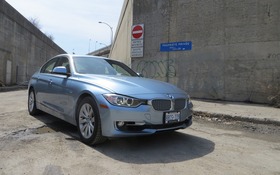2013 BMW ActiveHybrid 3: Battery-Powered Luxury, With A Twist

| Strong points |
|
|---|---|
| Weak points |
|
Luxury hybrid cars are nothing new, but the unique approach that several high end brands have taken when adopting battery technology separates them from their non-premium counterparts. It seems that for every Lexus RX 450h that leverages hybrid design to improve fuel efficiency, there's a vehicular counter-point that instead adds electric power to the mix in an effort to boost performance.
The 2013 BMW ActiveHybrid 3 is one such automobile. This electrified version of the venerable 3 Series sedan doesn't lean on its hybrid system to squeeze a few more kilometres of travel out of a tank - it barely beats the 335i's efficiency on the highway - but instead dumps most of that battery power to the rear wheels in order to offer startling acceleration. There are a few trade-offs that come with BMW's hybrid implementation, but overall the ActiveHybrid 3 is a very engaging four-door cruiser that can catch more than a few sports sedans sleeping when the red light shifts to green.
Green, All The Way Up To The Redline
How, exactly, does the 2013 BMW ActiveHybrid 3 deliver copious amounts of power while still keeping its fuel consumption relatively modest? The secret lies in the complicated array of gas-saving technologies that the German company has stuffed inside the sedan. First, the ActiveHybrid 3 features an automatic engine start/stop system (available on other, non-hybrid BMW models as well) that significantly reduces engine idle by killing the motor when the vehicle is stopped. Next, the engineers stuffed an electric motor inside the ActiveHybrid 3's eight-speed automatic transmission. This engine can step in at very low speeds to motivate the car on battery power alone, or when the vehicle is coasting down the highway.
The true purpose of the ActiveHybrid 3's electric motor, however, is to work in concert with the automobile's turbocharged 3.0-liter six-cylinder drivetrain to lessen its load while accelerating as well as provide additional 'oomph' when required. The hybrid car makes use of essentially the same engine found in the BMW 335i, which when combined with its battery-powered motor produces a total 335 horsepower and 332 lb-ft of torque. More importantly, the electric motor's 155 lb-ft of torque are available immediately upon throttle activation, which plays a huge role in the heavier-than-normal ActiveHybrid 3's ability to leap off of the line.
Quick, But Neither Smooth Nor Especially Nimble
The 2013 BMW ActiveHybrid 3 provides four different Driving Experience Control settings to help manage its power output and fuel consumption, accessible via a console-mounted toggle. Eco-Pro mode is the most frugal of the four, and also one of the least comfortable to use due to soggy response from the accelerator and an unusual power cut-out when turning low-speed, 90-degree corners. Comfort mode is better when it comes to approximating a 'normal' driving experience in the hybrid, while Sport and Sport+ dramatically tighten up the vehicle's shift pattern as well as tweak overall power delivery to give it a performance edge.
The main issue with using any of these modes, unfortunately, is the way they reveal the lack of smoothness that is inherent in the ActiveHybrid 3's drivetrain. Eco Pro lurches forward from a stop and shudders to a halt as the engine stumbles its way from ignition to rest under your right foot. The sensation is sharpened in both of the Sport modes, as a touchy gas pedal makes it difficult to modulate the hybrid system's power when not driving at 9/10ths. The brakes are also far less grabby than one would expect from such a high-performing automobile, and handling at the limit is betrayed by the additional 150 kilos of weight added on by the vehicle's battery.
An Interesting Mix Of Attributes
The 2013 BMW ActiveHybrid 3 is a luxury car that steps outside the standard hybrid stereotype and instead presents them with an unusual set of features and capabilities. Want all of the speed of a 335i with slightly better fuel economy (8.0 l/100 km city / 5.9 l/100 km highway)? The power to eclipse gas-only competitors from Audi and Mercedes-Benz while still being able to brag about your eco-cred around the corporate water cooler? A very comfortable car that drives quite well even at extra-legal speeds? The ActiveHybrid 3 is definitely all of these things, and although not quite as refined as it could be, objectively it's an excellent and rewarding automobile to pilot on a daily basis.
Unfortunately, BMW's least-expensive hybrid sedan's drivetrain doesn't feel quite as 'premium' as lesser lights in the 3 Series line-up, due to the stutter-step of its battery shuffle and engine start/stop system. Despite its entry-level status, it's also still really pricy. In fact, with a starting MSRP of $58,300 it's much closer to the territory occupied by mid-size luxury sedans than it is to its humbler roots. The ActiveHybrid 3's incremental performance gains and negligible efficiency improvements are honestly not worth $15,000 more than the BMW 328i, nor $7,000 more than a comparably-equipped 335i, but the hybrid touches on all of the important bases expected out of a BMW model, which is a notable achievement for a battery-assisted automobile.











